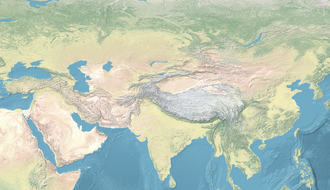Location of the Tashtyk culture (Minusinsk Depression) and contemporary Asian polities c. 100 Tashtyk culture funeral masks. The masks were often painted. Oglakhty necropolis, tomb 4, 3rd-4th century CE. Hermitage Museum. [1] [2] [3] [4] [5] | |
| Geographical range | South Central Siberia |
|---|---|
| Period | Iron Age |
| Dates | 1 CE–400 CE |
| Preceded by | Tagar culture |
| Followed by | Yenisei Kyrgyz |
The Tashtyk culture [a] was a Late Iron Age archaeological culture that flourished in the Yenisei valley in Siberia from the 1st century CE to the 4th century CE. Located in the Minusinsk Depression, environs of modern Krasnoyarsk, eastern part of Kemerovo Oblast, it was preceded by the Tagar culture and the Tesinsky culture. [6] [7]












